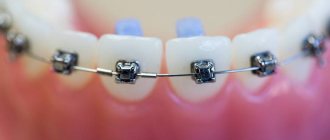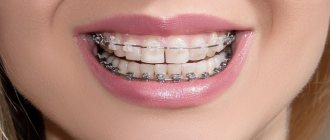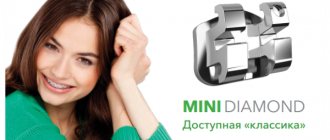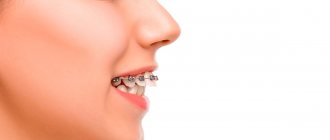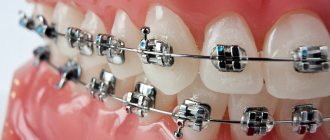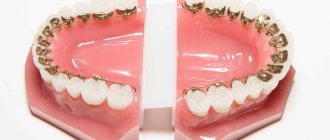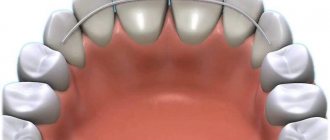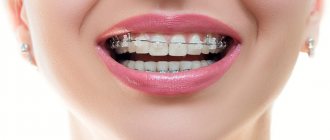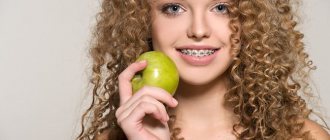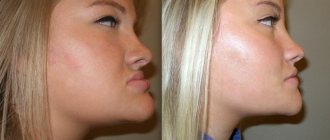Classic metal braces look rather bulky and unattractive on the teeth, which is the main reason for refusing to use them as a method of treating malocclusion. However, in the modern market of orthodontic systems there are interesting alternatives to traditional metal braces - the so-called aesthetic braces. This is a general name that includes several types of braces: plastic, ceramic, sapphire and lingual structures. The goal of all these types of braces is to preserve the aesthetics of your smile and make the treatment process less noticeable to others.
It is worth noting right away that aesthetic braces are not a panacea. Firstly, installing such a system will cost much more than a metal one. Secondly, not all aesthetic designs can successfully cope with complex pathologies of the dentition. Thirdly, some of them are much less strong, others are much more painful. In this article we will look at the pros and cons of all aesthetic braces.
The mechanism of bite correction using braces
Pathologies of occlusion can be congenital, caused by genetic predisposition or abnormalities of intrauterine development, or acquired, caused by bad habits or injuries to the dentofacial apparatus. The use of brace systems in corrective therapy makes it possible to effectively eliminate occlusion defects regardless of the reasons that gave rise to them.
The essence of the mechanism for correcting anomalies is based on the ability of teeth to move from their place under the influence of directed mechanical force. During the treatment process, the bone tissue in which the dental elements are located is thinned in the direction of the movement vector, and a new one is formed in the opposite direction. Thus, the calculated force pressure helps the tooth occupy a new place in the dental row.
The mechanical impact to achieve the goal of corrective therapy is created using bracket systems - non-removable orthodontic structures fixed to the surface of the tooth enamel.
Design features of ligature braces
All bracket systems have the same design:
- bracket plates fixed to the teeth using a special adhesive composition;
- a power arc that has “shape memory” (tends to straighten out from a bent position);
- fastening elements that attach the arch to the bracket plates.
If the arch is fixed to the teeth using miniature clips, then such braces are called non-ligating or self-ligating braces. If the arch is attached using ligatures, then such orthodontic structures are called ligature. This is, as they say, a “classic of the genre.”
Either small plastic rings or thin metal wire made of medical steel are used as ligatures.
Plastic ligatures can be of various shades: transparent, silver, colored. Teenagers, as a rule, prefer rich colors. While wearing, the ligatures stretch, so the doctor periodically changes or tightens them.
Note: compliance with the prescribed frequency of visits to the clinic during the correction course is the key to the effectiveness of the process. Otherwise, the result may not be achieved.
Ligature braces are effective in treating both adults and adolescents.
How often do you visit a doctor?
Treatment with ligature structures usually lasts from one and a half to three years.
To replace arches and ligatures, patients with classical systems visit an orthodontist every month. The doctor removes the ligatures, changes the archwires and puts on new elastic rings or fixes a metal wire on each bracket. The procedure takes from 20 to 35 minutes. Patients wear self-ligating devices for an average of one to two and a half years. The doctor makes an appointment once every two months and spends 15 to 25 minutes on the patient. Using a special SpinTek tool, the orthodontist opens the bracket cover and changes the arches.
positioning of the Damon Clear self-ligating bracket
Types of ligature systems
The main classification of braces is carried out depending on their positioning:
- those fixed on the outer side of the dental row are called vestibular;
- attached to the inner surface - lingual.
The material used to make orthodontic products also affects the type of bracket system:
- metal – bracket plates are made of a hypoallergenic metal alloy (cobalt, nickel or gold). Such designs are very reliable, efficient, affordable in cost, but their appearance is not aesthetically pleasing;
- ceramic - made of high-strength ceramics. Their color practically matches the shade of natural tooth enamel, so they have a high level of aesthetics. Cannot be used if excessive force pressure must be applied to correct defects (i.e., to correct severe pathologies). The price of such systems is significantly higher than similar metal products.
What braces are considered aesthetic and how to choose the best option for yourself
Classic metal braces spoil the aesthetics of your smile. Although the design has proven itself to be a reliable and effective means of correcting malocclusion, many people refuse to wear a massive arch and iron braces in their mouth for a long time. Volumetric braces stand out against the background of a snow-white smile, which creates complexes and makes a person smile less. Installing aesthetic braces can solve this problem.
aesthetic braces , which are almost invisible in the oral cavity, are becoming increasingly popular Let's consider what types of aesthetic orthodontic structures exist, what are their differences and advantages.
Indications and contraindications for installation
Any type of treatment should be prescribed exclusively by a specialist. Therefore, identifying indications and contraindications for correcting occlusion defects is a priority step, without which corrective therapy cannot be started.
Indications:
- Incorrect position of the jaws or individual teeth
- Tremas and diastemas (large distances between dental elements)
- Crowding of dental units
- Deep or crossbite
Contraindications:
- Periodontitis and periodontal disease
- Endocrine pathologies
- Severe cardiovascular diseases
- HIV;
- Tuberculosis
- Bone diseases (osteoporosis, osteomyelitis)
- Bleeding disorder
- Edentia (absence of many teeth)
- Oncology
- Mental illness
Important: An orthodontist identifies indications for starting corrective therapy with braces only after conducting a thorough hardware diagnosis. This is necessary to develop an adequate detailed treatment plan.
Stages of corrective therapy
Correcting anomalies of the dental system is a long and painstaking process consisting of several stages:
- visual and hardware diagnostics: computed tomography, teleradiography,
- rendering a verdict, making a diagnosis, determining indications and contraindications;
- development of a treatment plan;
- oral hygiene: treatment of teeth and gums, professional cleaning;
- taking individual measurements (casts or scanning), making a model, drawing up an estimate;
- production of braces;
- installation of a brace system for a patient;
- wearing the device with periodic system adjustments. The duration depends on the severity of the specific clinical case and is determined by the orthodontist;
- removal of braces and installation of a removable or non-removable retainer. The duration of retention also depends on the individual characteristics of the clinical case.
Specialist comment: the retention stage is very important for consolidating the achieved results. Failure to follow the recommendations of the attending orthodontist may invalidate the results of therapy, and everything will return to its previous position.
How much will the treatment cost?
To help you better navigate the choice of aesthetic design, the table below shows approximate prices for various types of braces.
| Types of systems | Cost for installation per 1 jaw |
| Plastic | from 35 thousand rubles. |
| Ceramic | from 55 thousand rubles. |
| Sapphire | from 70 thousand rubles. |
| Lingual | from 200 thousand rubles. |
| Standard metal ones with multi-colored rubber bands | from 45 thousand rubles. |
The exact cost will depend on a number of factors, including the complexity of the clinical case, the need to install additional corrective elements, the pricing policy of the dental clinic, etc.
Installation of ligature bracket system
The procedure for fixing the device takes about one and a half hours. What does the doctor do:
- washes the enamel, then thoroughly etches it with a special substance designed for better adhesion of the bracket plates to the surface of the enamel;
- applies an adhesive composition to the areas of future fixation of the plates;
- glues the plates and removes excess adhesive solution;
- threads a power arc into the grooves of the bracket plates;
- fixes the arch with ligatures.
Features of the adaptation period
The patient should be prepared to experience discomfort for several days or weeks (depending on the threshold of sensitivity):
- rubbing of the mucous membranes of the lips and cheeks;
- violation of diction;
- discomfort when eating.
Expert advice for minimizing discomfort:
- to prevent chafing, you can use special wax (sold in pharmacies);
- for minor pain, you should rinse your mouth 3-4 times a day with saline solution (1 tsp per glass of warm water). The procedure cannot be performed if there are wounds and abrasions in the mouth. In this case, it is better to use a soda solution in the same concentration;
- In case of severe pain, you need to take a tablet of any painkiller. Note: strictly follow the dosage indicated in the instructions for the medicine;
- In the first days after installing braces, cancel intense physical training. Yoga exercises will help during this period;
- learn to chop food with a knife, exclude excessively hard or sticky foods (dried, dried) from your diet. During the first few days, the products can be ground in a blender.
Attention: if the pain is severe and does not go away within several days, then you should definitely consult your doctor.
Reviews
Alina, 18 years old
When it comes to my health, I am always in favor of the reliability of the devices or materials used. The same goes for straightening teeth. I didn’t particularly pursue attractiveness; it was important for me to correct my bite. Metal braces were installed. I was lucky that the doctor was good and recommended that I install colored ligatures. I have already changed colors three times during corrections. It looks very cool. Although I wouldn’t be embarrassed to wear regular braces, colored ones are still more attractive.
Larisa, 38 years old
We also gave our son braces with colored ligatures. He was pleased. He says that all his friends like it. Everyone asks what it is, and even the girls began to pay more attention.
Anton, 29 years old
I was ready to give any money so that when straightening my teeth, my smile would not be an unattractive spot on my face. So I ordered lingual braces. True, I tore off my entire tongue while I was getting used to the structures, but then gradually it healed and now I wear it with sufficient comfort. No one notices that I have something in my mouth hidden behind my teeth.
Evgeniya, 22 years old
I doubted the choice of braces for a long time and finally settled on the golden mean. I chose ceramics. And the price is reasonable and they look good. The arch was painted so that it would not stand out when smiling. Now the fact that I have braces can only be understood by closely examining my teeth.
Hygienic care
The bracket design has many areas that are very difficult to clean from food debris and plaque. Therefore, hygienic care for them requires special attention and patience. Special devices are used for cleaning (in addition to a regular toothbrush and paste):
- V-shaped brushes;
- brushes of different sizes and bristle angles;
- dental floss (floss);
- irrigator is a device for cleaning hard-to-reach places between teeth and orthodontic elements. The principle of operation is based on the controlled supply of a stream of water (or solution) under pressure.
You should clean your mouth while wearing braces twice a day. Ideally, after every meal. But, if this is not possible, then you need to rinse your mouth thoroughly after eating.
Flaws:
- gradually lose elasticity and require replacement of component elements;
- act slowly: teeth, moving, are forced to overcome friction;
- may lead to discomfort due to the fixed fixation of the arch;
- bulky design requires complex maintenance;
- food coloring can stain rubber bands;
- cannot be used for periodontal disease and periodontitis;
- the need for monthly visits to the doctor.
Rice. 1 Ligature braces
Diet restrictions
To prevent braces from breaking or changing the vector of force, you need to reconsider your diet. Orthodontists recommend:
- hard vegetables and fruits must be grated or crushed in a brander before use;
- You cannot bite seeds, chew gum, eat nuts, dried apricots and other dried fruits;
- Avoid consuming very hot or extremely cold foods and drinks;
- limit the intake of food and drinks containing artificial or natural colors (tea, coffee, red wine, soda, berries, etc.).
Important: failure to follow the recommendations given by a specialist may result in system failure. In this case, the device will need to be repaired, which will lead to an increase in the correction period and an increase in the cost of treatment.

